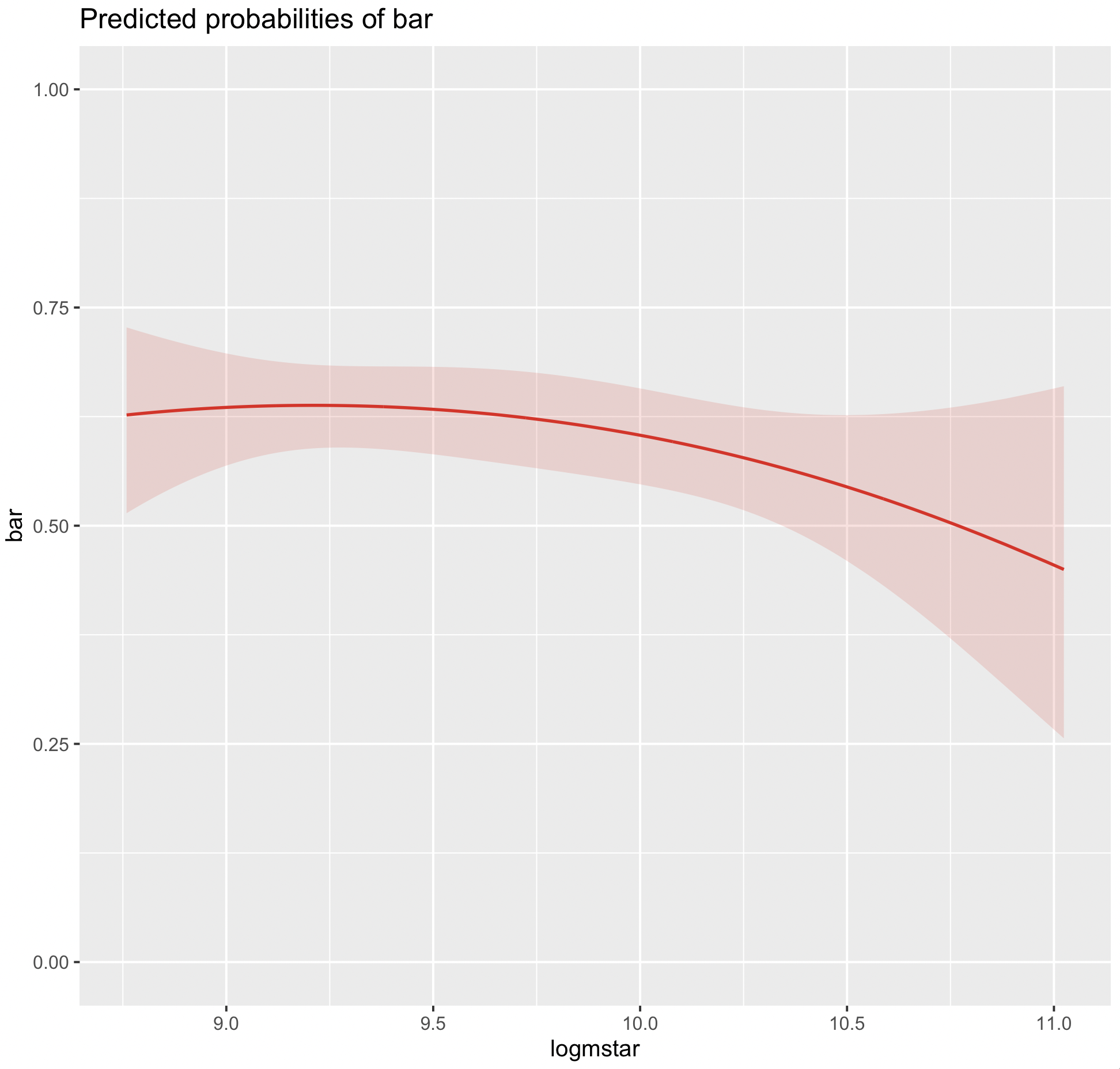I'm trying to experiment with using natural cubic splines for logistic regression in R, and I'm having trouble interpreting and making use of the results.
For a variety of reasons, I need to be able to plot (and possibly further analyze) the results in Python. The problem is that while I can do this with standard logistic regression, I don't know how to do this for the case of logistic regression using (natural cubic) splines.
An example: doing logistic regression on the frequency of stellar bars in spiral galaxies, as a function of the total stellar mass of individual galaxies. (Here's a link to the data file, if you want to try fitting things yourself.)
If I do standard logistic regression with a quadratic logit function -- as I did with an earlier version of the dataset in Erwin 2018 [Github link to Python and R notebooks: https://github.com/perwin/s4g_barfractions], I get something like this in R (stripping away some of the output):
ff <- "barpresence_vs_logmstar_for_R_sp_w30_updateddist.txt"
logmstarBarSpTable <- read.table(ff, header=TRUE)
logMstarFitSp_quad <- glm(bar ~ logmstar + I(logmstar^2),
family = binomial, logmstarBarSpTable)
summary(logMstarFitSp_quad)
Coefficients:
Estimate Std. Error z value Pr(>|z|)
(Intercept) -19.2096 26.0781 -0.737 0.461
logmstar 4.2945 5.3723 0.799 0.424
I(logmstar^2) -0.2332 0.2760 -0.845 0.398
AIC: 828.4
I can easily plot the result in Python, since I know the "Coefficients" values correspond to coefficients in a quadratic equation:
logit = beta_0 + beta_1*x + beta_2*x^2
where beta_0 = "(Intercept)", beta_1 = "logmstar", and beta_2 = "I(logmstar^2)", so the actual expression becomes
logit = -19.2096 + 4.2945*x - 0.2332*(x**2)
and then I can generate probability values with Python code like this:
probability = 1.0 / (1.0 + np.exp(-logit))
Here's the result of asking R to plot the fit, via
plot_model(logMstarFitSp_quad, type = "pred", terms = c("logmstar"))
and here's the result of doing the same in Python, which agrees nicely:
def logit_quad( x, params=[-19.2096, 4.2945, -0.2332] ):
return params[0] + params[1]*x + params[2]*(x**2)
xx = np.arange(8.5,11,0.01)
plt.plot(xx, 1.0 / (1.0 + np.exp(-logit_quad(xx)))
If on the other hand I try doing a simple natural-cubic-spline logistic regression in R (for simplicity, starting off with just one internal knot, so df=2) I get:
require("splines")
logMstarFitSp_spline2df <- glm(bar ~ ns(logmstar, 2),
family = binomial, logmstarBarSpTable)
summary(logMstarFitSp_spline2df)
Coefficients:
Estimate Std. Error z value Pr(>|z|)
(Intercept) 0.5049 0.2285 2.210 0.0271 *
ns(logmstar, 2)1 -0.2487 0.5061 -0.492 0.6231
ns(logmstar, 2)2 -0.7645 0.4276 -1.788 0.0738 .
AIC: 828.16
For what it's worth, I can figure out that the single internal knot is located at logmstar = 9.5575, via
str(attributes(summ$terms)$predvars)
language list(bar, ns(logmstar, knots = c(`50%` = 9.5575), Boundary.knots = c(8.759, 11.024), intercept = FALSE))
... and I have no idea how to interpret this, or what the logit expression would look like in Python. What are the "Coefficients" in this model?
In principle, I think they should be the coefficients that multiply the basis functions of the spline, so that
logit = beta_0*h_1(x) + beta_1*h_2(x) + beta_1*h_3(x)
where h_1, h_2, and h_3 are the three basis functions (and beta_0 = "(Intercept)", etc.).
But what are the basis functions? (My attempts to read the documentation for the R function ns have left me baffled; and I have not found much help in various spline-requested questions on this site.)



rms::Glminstead ofstats::glm, there is a much easier way to obtain the equations, by usingFunction, as described here $\endgroup$splines::ns(...)outside of your logistic fit), and export that as a CSV file (maybe not what you want); (2) generate equivalent spline bases in Python, e.g. using thepatsylibrary as in this answer (it may take a bit of fussing to get all the arguments/defaults to match up with R's); (3) use a truncated power basis (as inrms::rcsorrms::rcspline.eval), which is not as numerically nice but is analytically simpler $\endgroup$